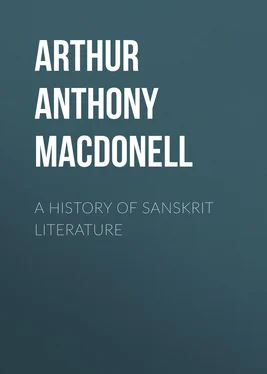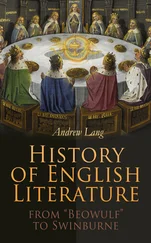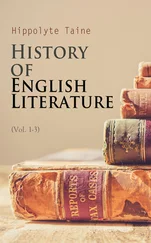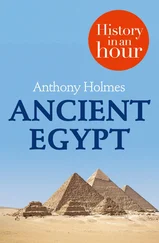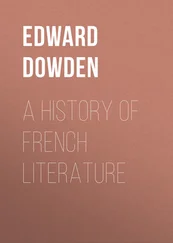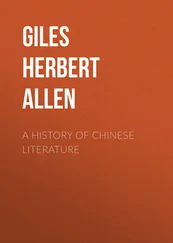Arthur Anthony MacDonell - A History of Sanskrit Literature
Здесь есть возможность читать онлайн «Arthur Anthony MacDonell - A History of Sanskrit Literature» — ознакомительный отрывок электронной книги совершенно бесплатно, а после прочтения отрывка купить полную версию. В некоторых случаях можно слушать аудио, скачать через торрент в формате fb2 и присутствует краткое содержание. Жанр: foreign_prose, foreign_antique, на английском языке. Описание произведения, (предисловие) а так же отзывы посетителей доступны на портале библиотеки ЛибКат.
- Название:A History of Sanskrit Literature
- Автор:
- Жанр:
- Год:неизвестен
- ISBN:нет данных
- Рейтинг книги:5 / 5. Голосов: 1
-
Избранное:Добавить в избранное
- Отзывы:
-
Ваша оценка:
- 100
- 1
- 2
- 3
- 4
- 5
A History of Sanskrit Literature: краткое содержание, описание и аннотация
Предлагаем к чтению аннотацию, описание, краткое содержание или предисловие (зависит от того, что написал сам автор книги «A History of Sanskrit Literature»). Если вы не нашли необходимую информацию о книге — напишите в комментариях, мы постараемся отыскать её.
A History of Sanskrit Literature — читать онлайн ознакомительный отрывок
Ниже представлен текст книги, разбитый по страницам. Система сохранения места последней прочитанной страницы, позволяет с удобством читать онлайн бесплатно книгу «A History of Sanskrit Literature», без необходимости каждый раз заново искать на чём Вы остановились. Поставьте закладку, и сможете в любой момент перейти на страницу, на которой закончили чтение.
Интервал:
Закладка:
The gods, in the view of the Vedic poets, had a beginning; for they are described as the offspring of heaven and earth, or sometimes of other gods. This in itself implies different generations, but earlier gods are also expressly referred to in several passages. Nor were the gods regarded as originally immortal; for immortality is said to have been bestowed upon them by individual deities, such as Agni and Savitṛi, or to have been acquired by drinking soma. Indra and other gods are spoken of as unaging, but whether their immortality was regarded by the poets as absolute there is no evidence to show. In the post-Vedic view it was only relative, being limited to a cosmic age.
The physical aspect of the Vedic gods is anthropomorphic. Thus head, face, eyes, arms, hands, feet, and other portions of the human frame are ascribed to them. But their forms are shadowy and their limbs or parts are often simply meant figuratively to describe their activities. Thus the tongue and limbs of the fire-god are merely his flames; the arms of the sun-god are simply his rays, while his eye only represents the solar orb. Since the outward shape of the gods was thus vaguely conceived, while their connection with natural phenomena was in many instances still evident, it is easy to understand why no mention is made in the Rigveda of images of the gods, still less of temples, which imply the existence of images. Idols first begin to be referred to in the Sūtras.
Some of the gods appear equipped as warriors, wearing coats of mail and helmets, and armed with spears, battle-axes, bows and arrows. They all drive through the air in luminous cars, generally drawn by horses, but in some cases by kine, goats, or deer. In their cars the gods come to seat themselves at the sacrifice, which, however, is also conveyed to them in heaven by Agni. They are on the whole conceived as dwelling together in harmony; the only one who ever introduces a note of discord being the warlike and overbearing Indra.
To the successful and therefore optimistic Vedic Indian, the gods seemed almost exclusively beneficent beings, bestowers of long life and prosperity. Indeed, the only deity in whom injurious features are at all prominent is Rudra. The lesser evils closely connected with human life, such as disease, proceed from minor demons, while the greater evils manifested in Nature, such as drought and darkness, are produced by powerful demons like Vṛitra. The conquest of these demons brings out all the more strikingly the beneficent nature of the gods.
The character of the Vedic gods is also moral. They are “true” and “not deceitful,” being throughout the friends and guardians of honesty and virtue. But the divine morality only reflects the ethical standard of an early civilisation. Thus even the alliance of Varuṇa, the most moral of the gods, with righteousness is not such as to prevent him from employing craft against the hostile and the deceitful man. Moral elevation is, on the whole, a less prominent characteristic of the gods than greatness and power.
The relation of the worshipper to the gods in the Rigveda is in general one of dependence on their will, prayers and sacrifices being offered to win their favour or forgiveness. The expectation of something in return for the offering is, however, frequently apparent, and the keynote of many a hymn is, “I give to thee that thou mayst give to me.” The idea is also often expressed that the might and valour of the gods is produced by hymns, sacrifices, and especially offerings of soma. Here we find the germs of sacerdotal pretensions which gradually increased during the Vedic age. Thus the statement occurs in the White Yajurveda that the Brahman who possesses correct knowledge has the gods in his power. The Brāhmaṇas go a step farther in saying that there are two kinds of gods, the Devas and the Brahmans, the latter of whom are to be held as deities among men. In the Brāhmaṇas, too, the sacrifice is represented as all-powerful, controlling not only the gods, but the very processes of nature.
The number of the gods is stated in the Rigveda itself to be thirty-three, several times expressed as thrice eleven, when each group is regarded as corresponding to one of the divisions of the threefold universe. This aggregate could not always have been deemed exhaustive, for sometimes other gods are mentioned in addition to the thirty-three. Nor can this number, of course, include various groups, such as the storm-gods.
There are, however, hardly twenty individual deities important enough in the Rigveda to have at least three entire hymns addressed to them. The most prominent of these are Indra, the thunder-god, with at least 250 hymns, Agni with about 200, and Soma with over 100; while Parjanya, god of rain, and Yama, god of the dead, are invoked in only three each. The rest occupy various positions between these two extremes. It is somewhat remarkable that the two great deities of modern Hinduism, Vishṇu and Çiva, who are equal in importance, should have been on the same level, though far below the leading deities, three thousand years ago, as Vishṇu and Rudra (the earlier form of Çiva) in the Rigveda . Even then they show the same general characteristics as now, Vishṇu being specially benevolent and Rudra terrible.
The oldest among the gods of heaven is Dyaus (identical with the Greek Zeus). This personification of the sky as a god never went beyond a rudimentary stage in the Rigveda , being almost entirely limited to the idea of paternity. Dyaus is generally coupled with Pṛithivī, Earth, the pair being celebrated in six hymns as universal parents. In a few passages Dyaus is called a bull, ruddy and bellowing downwards, with reference to the fertilising power of rain no less than to the lightning and thundering heavens. He is also once compared with a black steed decked with pearls, in obvious allusion to the nocturnal star-spangled sky. One poet describes this god as furnished with a bolt, while another speaks of him as “Dyaus smiling through the clouds,” meaning the lightening sky. In several other passages of the Rigveda the verb “to smile” ( smi ) alludes to lightning, just as in classical Sanskrit a smile is constantly compared with objects of dazzling whiteness.
A much more important deity of the sky is Varuṇa, in whom the personification has proceeded so far that the natural phenomenon which underlies it can only be inferred from traits in his character. This obscurity of origin arises partly from his not being a creation of Indian mythology, but a heritage from an earlier age, and partly from his name not at the same time designating a natural phenomenon, like that of Dyaus. The word varuṇa-s seems to have originally meant the “encompassing” sky, and is probably the same word as the Greek Ouranos , though the identification presents some phonetic difficulties. Varuṇa is invoked in far fewer hymns than Indra, Agni, or Soma, but he is undoubtedly the greatest of the Vedic gods by the side of Indra. While Indra is the great warrior, Varuṇa is the great upholder of physical and moral order ( ṛita ). The hymns addressed to him are more ethical and devout in tone than any others. They form the most exalted portion of the Veda, often resembling in character the Hebrew psalms. The peaceful sway of Varuṇa is explained by his connection with the regularly recurring celestial phenomena, the course of the heavenly bodies seen in the sky; Indra’s warlike and occasionally capricious nature is accounted for by the variable and uncertain strife of the elements in the thunderstorm. The character and power of Varuṇa may be sketched as nearly as possible in the words of the Vedic poets themselves as follows. By the law of Varuṇa heaven and earth are held apart. He made the golden swing (the sun) to shine in heaven. He has made a wide path for the sun. The wind which resounds through the air is Varuṇa’s breath. By his ordinances the moon shining brightly moves at night, and the stars placed up on high are seen at night but disappear by day. He causes the rivers to flow; they stream unceasingly according to his ordinance. By his occult power the rivers swiftly pouring into the ocean do not fill it with water. He makes the inverted cask to pour its waters and to moisten the ground, while the mountains are wrapt in cloud. It is chiefly with these aërial waters that he is connected, very rarely with the sea.
Читать дальшеИнтервал:
Закладка:
Похожие книги на «A History of Sanskrit Literature»
Представляем Вашему вниманию похожие книги на «A History of Sanskrit Literature» списком для выбора. Мы отобрали схожую по названию и смыслу литературу в надежде предоставить читателям больше вариантов отыскать новые, интересные, ещё непрочитанные произведения.
Обсуждение, отзывы о книге «A History of Sanskrit Literature» и просто собственные мнения читателей. Оставьте ваши комментарии, напишите, что Вы думаете о произведении, его смысле или главных героях. Укажите что конкретно понравилось, а что нет, и почему Вы так считаете.
